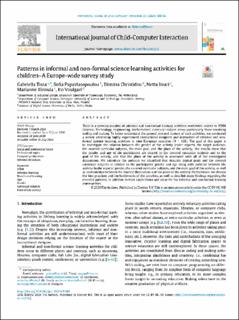| dc.contributor.author | Tisza, Gabriella | |
| dc.contributor.author | Papavlasopoulou, Sofia | |
| dc.contributor.author | Christidou, Dimitra | |
| dc.contributor.author | Iivari, Netta | |
| dc.contributor.author | Kinnula, Marianne | |
| dc.contributor.author | Voulgari, Iro | |
| dc.date.accessioned | 2020-11-30T07:41:04Z | |
| dc.date.available | 2020-11-30T07:41:04Z | |
| dc.date.created | 2020-07-17T12:12:56Z | |
| dc.date.issued | 2020 | |
| dc.identifier.citation | International Journal of Child-Computer Interaction. 2020, 25 . | en_US |
| dc.identifier.issn | 2212-8689 | |
| dc.identifier.uri | https://hdl.handle.net/11250/2690044 | |
| dc.description.abstract | There is a growing number of informal and non-formal learning activities worldwide related to STEM (Science, Technology, Engineering, Mathematics) curricular subject areas—particularly those involving coding and making. To better understand the general aim and content of such activities, we conducted a survey addressing highly experienced instructional designers and instructors of informal and non-formal science learning activities in nine European countries (N = 128). The goal of this paper is to investigate the relation between the gender of the activity leader experts, the target audience, the covered curricular subjects, the main goal, and the place of the activity. The results show that the gender and age of the participants are related to the covered curricular subjects and to the goal of the activity, and that the place of the activity is associated with all of the investigated dimensions. We introduce the patterns we identified that describe typical goals and the covered curricular subjects in relation to the participants’ gender and age along with patterns between the activity leader experts’ gender, the covered curricular subjects, and the main goal of the activity, as well as relationships between the studied dimensions and the place of the activity. Furthermore, we discuss the best practices and the bottlenecks of the activities, as well as detailed study findings regarding the revealed patterns, in addition to their implications and value for the informal and non-formal learning communities. | en_US |
| dc.language.iso | eng | en_US |
| dc.publisher | Elsevier | en_US |
| dc.rights | Attribution-NonCommercial-NoDerivatives 4.0 Internasjonal | * |
| dc.rights.uri | http://creativecommons.org/licenses/by-nc-nd/4.0/deed.no | * |
| dc.title | Patterns in informal and non-formal science learning activities for children–A Europe-wide survey study | en_US |
| dc.type | Peer reviewed | en_US |
| dc.type | Journal article | en_US |
| dc.description.version | publishedVersion | en_US |
| dc.source.pagenumber | 11 | en_US |
| dc.source.volume | 25 | en_US |
| dc.source.journal | International Journal of Child-Computer Interaction | en_US |
| dc.identifier.doi | https://doi.org/10.1016/j.ijcci.2020.100184 | |
| dc.identifier.cristin | 1819703 | |
| dc.relation.project | EC/H2020/787476 | en_US |
| dc.description.localcode | ©2020 The Authors. Published by Elsevier B.V. This is an open access article under the CCBY-NC-ND license (http://creativecommons.org/licenses/by-nc-nd/4.0/) | en_US |
| cristin.ispublished | true | |
| cristin.fulltext | original | |
| cristin.qualitycode | 1 | |

